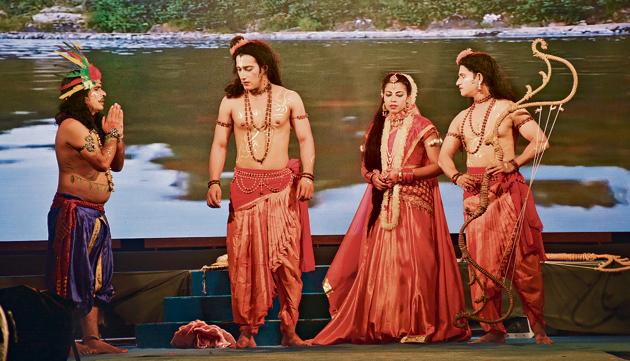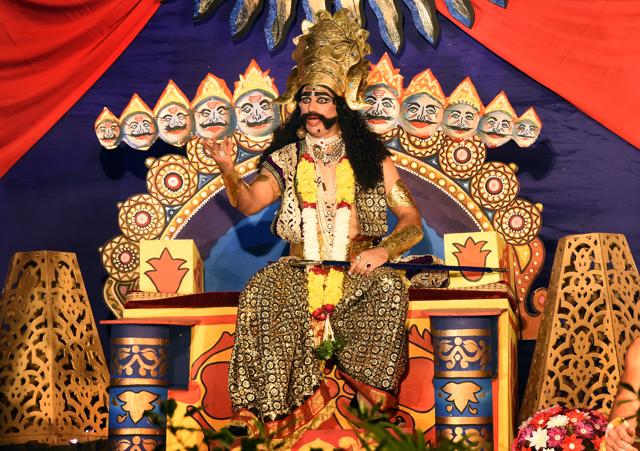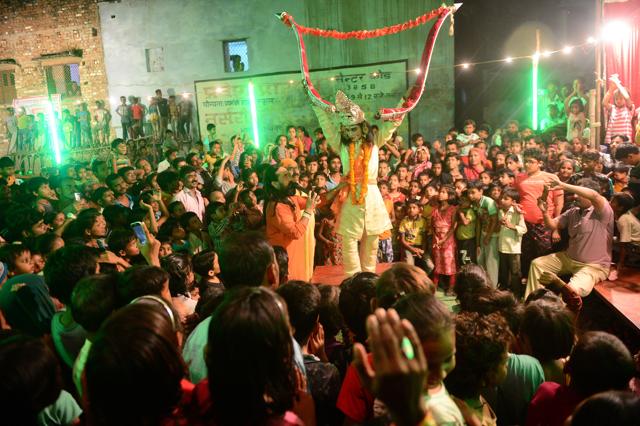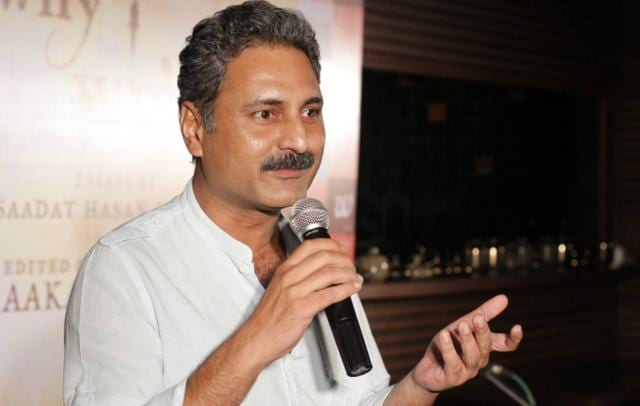Epic catharsis: Mahmood Farooqui on staging the Ramleela in Tihar jail
Inmates of the country’s largest prison, drawn to Ram’s infinitely forgiving self, participate enthusiastically in the enactment of his life and struggles
The stand out moment in this year’s Ramleela performance by the Tihar Drama Class came when Kumbhkaran, facing Lakshman in battle, suddenly lost his voice. This was very disappointing, because the audience in Jail no 3 at Tihar love their Kumbhkaran. For four years now, Basantlal, son of Nathulal, who plays the part, has been regaling them with his antics. A stout man in his late fifties who sports a colonel’s moustache, his Kumbhkaran is able to tide over Lakshman’s jibes about his rotundity with swagger and elan. The most eagerly awaited part of his performance comes when he is woken up from his slumber and asks for meat and booze. The inmates cheer wildly when he tells his minions that if there is any shortage, they should get the booze from the Superintendent’s office. Saying that he breaks one ghara after another. It was unfortunate therefore that he lost his voice this year at a critical point in the battle because, as everyone knows, battles in Ramleela are fought less with bows and arrows than with fiery and rhyming dialogues. But to compensate for that disappointment this year was the added attraction of background music. Using a beat up old synthesizer, Francis, an inmate from Agra, and his associate Indal on the tabla, provided the atmospherics that heightened the effect of the theatrics on stage.
Though the inmates love their Kumbhkaran, the entry that is most awaited is Ravana’s. Bhanu, the inmate in charge of the Drama Class, plays Ravana. He is tall, muscular and has a booming voice and when he enters the stage reciting Ravana’s Shiv stotram, it is as spectacular an entry as one would like Ravana to have. Those who understand Bollywood grammar know that the hero’s ‘entry’ is the most important part of a film and like Gabbar Singh in the film Sholay, it is Ravana who is the lead attraction in the performance of Ram Leela.


With his physicality, his energy and his supreme confidence, Bhanu assays a Ravana that could give any professional actor a run for his money. Of Bollywood actors that I know of, perhaps only the late Amrish Puri could match Bhanu for the way he commands the stage and dominates other actors. It helps that he has been helming the part for four years now, and has played the lead in several other full-length plays. This year too, his entry was received with raucous applause. The most lusty laughter though, predictably, came when Firoz, who was playing Sita, proved inept in handling his sari and kept dropping his pallu. But all was forgotten at the Jaimala, which was accompanied by a song that is still played in weddings in Awadh and which evokes a very approachable image of Ram as a son-in-law:
Jhuk jaiyyo Lala Raghubeer
Lalli mori chhoti hai
(Do please bow a bit my Lalla Raghubeer
Because our Lalli is short)
I founded the Drama Class in Tihar when I was sent to prison after my conviction in 2016. I was working with inmates who were either illiterate or could barely read or write Hindi. We started with Premchand’s short story Nasha, and buoyed by its success, launched into Swadesh Dipak’s Court Martial, one of the most successful Hindi plays of the last few decades. To get illiterate actors to memorise long passages of dialogues, sometimes in English, was a challenge but for the same reason it was doubly rewarding. I learnt that, provided the right atmosphere and grind, anybody can become an Actor. Court Martial is about a murder trial, and about caste oppression even in the Army, and lays bare the provocation that led to a common solider murdering his officer. Naturally, the themes resonated deeply with inmates and provided considerable catharsis wherever we performed it. The then Director General Sudhir Yadav took a keen interest in the Drama Class and would go on to host the historic Tihar Kala Abhiyan in 2017 when inmates showcased their impressive artistic talent at different venues in Delhi.

It was the success of Court Martial that emboldened us to perform Ramleela. When I assented to the proposal from some members of the group I had little idea about the technicalities of performing Ramleela. What we did know was that given our logistic limitation we would have to compress the 10 day performance to a single day. I started my search by poring over the Hindi translation of Valimiki’s Ramayana and Tulsidas’s Ram Charit Manas, texts that are easily available in prison libraries in India. It was Basantlal who disabused me of my ignorance. He rolled off the episodes that he said are a must in a Ramleela performance: the Sita Swaymwara, the Sita Haran, Jatayu Vadh, the Ram-Sugreev Samvad, Meghnad-Lakshman Sangram. I realised that my vaunted knowledge of the Ramayana was of little use here. Several members of my group had seen innumerable Ramleelas and knew that the performance of Ram’s Leela differed considerably from the sacred epic. When word got around about our intention to stage the Ramleela, we were surprised to meet several inmates who had actually participated in Ramleelas. One of them played out for us Jatayu’s death scene, with remarkable ventriloquism and pathos. Another told us about several Ramleela scripts that were in vogue but the best of them, he said, was Jaswant Singh’s Ramleela because it contained the best ghazals! Another alerted us to the importance of punchy dialogues. What he meant were dialogues such as this one, spoken by Ravana when he arrives uninvited to Sita’s Swayamwar and taunts Ram and Lakshman:
Kar lenge yadi chhokre veeron ke kaam ko
To kaun janega duniya mein Raavan ke naam ko
And so we tried to get the script. The one we first got our hand on was Radheshyam Katha Vachak’s Ramayana. Radheshyam was a celebrated playwright of the Parsi theatre era. This style of commercial theatre which flourished before independence left a deep imprint on our cinema and virtually invented the modern Indian musical. Consisting of troupes that ran into hundreds, these companies were like giant studios that roamed across India, sometimes by hiring entire trains, and performed to packed nights of thousands, night after night. In Radhe Shyam’s memoir, as of his other contemporaries such as Narayan Prasad Betab’s, we learn of the indispensable command over Urdu that this style required. The modern performances of Ramleela were also born at the same time and therefore share many elements of that era — the styling of costumes, the painted backdrops, the drop curtains, the mannered performance and above all the use of rhyming Urdu dialogues, complete with shers and ghazals. There is a long tradition of composing Ramayanas in Persian which began with the translation commissioned by Emperor Akbar. Masih Panipati’s 18th century Farsi Ramayana has been much praised. There have, of course, also been innumerable Urdu versions of the Ramayana too, right from Munshi Jagannath Lal Khushtar’s translation that was published in 1860, to Betab Barelvi, Maharaj Bahadur Barq, Brij Narayan Chakbast, and Saghar Nizami’s.

But none of the above worked for us because what we wanted was something that had the rasa of performance, not of text to read. Radhe Shyam’s version was too polished and urbane. There is no mujra, for instance, when Ravana’s darbar is introduced. And what good is a Ravana Darbar scene without an ode to wine, to the wine-server (the famous Saqi of Omar Khayyam vintage) and without some gyrations from nubile women. We were overjoyed, therefore, to find Raghunandan Sahir’s version of the Ramleela, which fulfilled all these criteria. It was replete with ghazals, geets, nazms and shayari and, in conformance with most medieval literature including the Guru Granth Sahib, often the tarz, or the tune, of the song was also suggested. Sita’s song of lament, it was proffered, should be sung to the tune of Sehgal’s immortal song Gham Diye Mustaqil. It also had the right kind of dialaagbazi, which is the quintessence of a heroic performance in India, from NT Rama Rao to Amitabh Bachchan and Rajnikanth. So we used the text to supplement the lived memory of some of our actors and chose eight key episodes. Since we didn’t have the luxury of lights or wings, we had to perforce erase the distinction between the actors and the audience, a distinction unknown to Sanskrit playwrights or our folk performers. We tied a mesh of ropes above the stage to hang mikes from it. We improvised swords and arrows from boxes and cartons. We couldn’t use any fireworks so we had to skip the Lanka burning and Ravana Dahan scenes. But in the end, the performance was extremely well received. Since then it has become an annual feature and now the senior inmates of the Class are able to put up a Ramleela on their own. When I went to watch the performance this year, I was impressed to see the scale of participation from people who normally stay far away from the Drama Class. The painting class spent hours doing the make up of the artistes, the music people, the carpenters, the stage decorators were all out in full strength. Although our plays are generally popular, this kind of voluntary and enthusiastic participation is reserved for Ramleela alone.
Read more: Review: Begunah Qaidi by Abdul Wahid Sheikh
A Ramleela performance not only reinforces our moral universe, but also creates and recreates a moral community, one which historically cut across religious lines. The late Urdu writer Intizar Husain repeatedly wrote about his indescribable joy in watching Ramleela performances. The Ramleela was once an indispensable part of our cultural landscape, but its prominence and ubiquity is declining in our cities now. It has increasingly become a subaltern pastime and perhaps that’s why it arouses so much enthusiasm among inmates. As with most oral epics, they always-already know the performance, and their anticipation of what would happen in fact redoubles their joy. For the same reason there is no burden on us to tell the entire story or even to tell it sequentially. For two hours we were lost in Ravana’s mesmerising arrogance, Lakshman’s angry young man ebullience, and Ram’s dignity. Above all what resonates with inmates is Ram’s limitless compassion and his infinitely forgiving self. At the end of the epic he instructs Lakshmana to go and sit at Ravana’s feet and take lessons in niti from him. Ram is also the last resort of the poor, the dispossessed, the oppressed, the God who looks after the deen-heen. Tulsidas calls him gareebnavaj, the ‘caretaker of the poor’, the epithet usually associated with the Sufi Saint of Ajmer. It needs no iteration that most inmates are poor and oppressed. When we watch the Ramleela, therefore, the tyranny of the jail staff, the cruelty of interminable incarcerations and the sufferings of our families pale in the face of this epic battle and the wrongs that Rama had to suffer. This is catharsis in the best Aristotelian sense of the term. This year the performance stretched longer than expected and inmates were thus allowed to remain outside long after sunset. The performers reward was specially made pakoris. These may seem small joys on the outside, but such is the meagre fare that a prisoner’s fantasies are made up of.

It is said that when the gods approached Vishnu to take rebirth as Krishna he flatly refused, saying he had suffered too much as Rama and therefore he was disinclined to take human form again. It was then that they said that don’t worry, in your incarnation as Krishna, there will be less Yog and more Bhog for you. Dara Shikoh writes in the introduction to his Persian translation of the Sanskrit text Yog Vashisht about his dream where Ram’s Guru Vashisht introduces him to Ram by saying that this here Dara is your younger brother. The historian Muzaffar Alam suggests that Dara’s endeavour in this translation was to portray for us what a modern Ram Rajya may look like and how Dara may be the best person to execute it. Ram is an ideal for us because of his ability to sublimate conflict into harmony and because he treats everyone with equal respect. Rama reconciles, he heals, he unites. More than ever we need discussions and conversations about Rama. The last person who made Ram Rajya an inalienable part of our political vocabulary was Mahatma Gandhi. We seem to still, albeit in a shrinking way, revere the man who immortalised for us the slogan He Ram. But if our newspapers and magazines are any guide we don’t seem too enthusiastic about the God who inspired him. There is less coverage of Ram even at Dussehra than of the temple-mosque controversy which bears his name. In the typically pragmatic Indian way, the Ramleela brings devotion and entertainment together. We can never have too much of Ram or his Leela. As the great Iqbal had said:
Hai Ram ke vajood pe Hindostan ko naaz
Ahl-e nazar samajhte hain unko Imam-e Hind
(Hindostan is forever proud of the existence Of Rama
The wise ones know that He is the leader of all Indians)
Mahmood Farooqui is a Delhi based writer best known for reviving Dastangoi, the lost Art of Urdu storytelling






